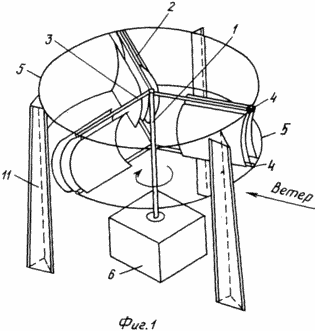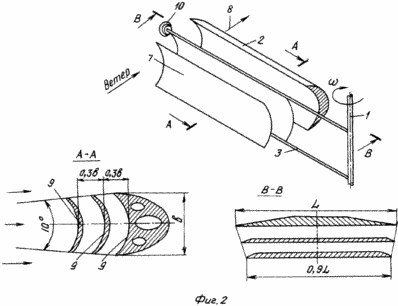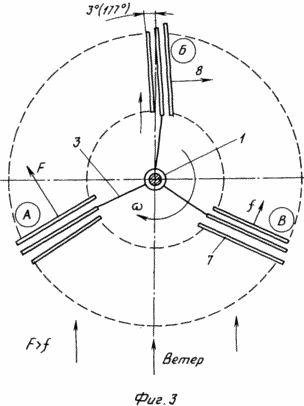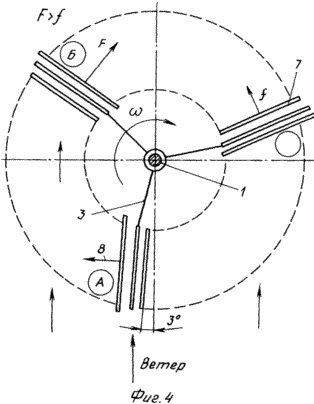| Start of section
Production, amateur Radio amateurs Aircraft model, rocket-model Useful, entertaining |
Stealth Master
Electronics Physics Technologies Inventions |
Secrets of the cosmos
Secrets of the Earth Secrets of the Ocean Tricks Map of section |
|
| Use of the site materials is allowed subject to the link (for websites - hyperlinks) | |||
Navigation: => |
Home / Patent catalog / Catalog section / Back / |
|
INVENTION
Patent of the Russian Federation RU2283968
![]()
Wind turbine for wind turbine
The name of the inventor: Lisnyak Stanislav Afanasievich (RU); Vyalykh Sergey Vasilievich (RU)
The name of the patent owner: Lisnyak Stanislav Afanasievich (RU); Vyalykh Sergey Vasilyevich
Address for correspondence: 690001, Vladivostok, ul. Pushkinskaya, 37, FESTU, Patent Department, M.I. Zvonarevu
Date of commencement of the patent: 2005.02.21
The invention relates to wind energy and can be used to convert wind energy into mechanical rotation of the windmill shaft, to which various mechanical devices or mechanical energy converters can be connected. The technical result consists in simplifying the design of the windmill, reducing its weight and size characteristics, increasing the wind energy utilization factor, is ensured by the fact that in a windmill containing a wind wheel with a vertical axis of rotation equipped with at least three wind-receiving elements fastened with radial traverses fixed On the vertical axis of rotation perpendicular to it, the outer ends of the traverse being supported by an annular support, in addition, the wind wheel is arranged to interact with the electric power generator, according to the invention, each wind-receiving element is made in the form of a slit wing comprising at least two parallel blades, Sections of which are crescent-shaped, convex towards the rotation of the wind wheel and concave from the side of the wind-receiving surfaces, while the width and length of the slit-blade blades increases from its surface receiving the wind by no less than 5% of the adjacent smallest, Of each slit wing is given a drop-like shape, for which the radius of curvature of the profile of the central part of its convex surface is less than that of the other slit-blade blades.
DESCRIPTION OF THE INVENTION
The invention relates to devices for converting wind energy into mechanical rotation of a windmill shaft, to which various mechanical devices or mechanical energy converters can be connected.
A wind turbine is known in which, in the central region of the stream, the wind acts directly on the multiblade rotor, and on the right and left of the flow there are movable flaps, along the perimeter outside the rotor (on the left, the flow is opened and on the right is blocked), these flaps being used as a guide for Direction of the wind flow to the rotor (see RF patent No. 2074980).
The drawback of this solution is that the wind utilization sector does not exceed 120 °, but the overall dimensions of the entire device are significantly increased and the design is complicated even in comparison with the paddle wind turbine.
Known wind turbine, made in the form of an axial turbine with a nozzle apparatus and containing an electric generator, front, central, additional and outer shells. The enumerated shells create three channels between adjacent surfaces, each of which is a Laval nozzle (see RF patent No. 2141422).
According to the author, this design provides high efficiency of wind use, which is very controversial, since the diameter of the outer shell is more than an order of magnitude larger than the diameter of the turbine itself, so the aerodynamic moment of the shell will be almost a thousand times greater than the resistance of the turbine. The author's statement that the investment of 1 kW of such a wind power will not exceed 0.25 of the capital investment for a classic windmill does not stand up to criticism (currently the world's capital investments for 1 kW of wind turbine power averages 1500-2000 $).
Also known is a wind turbine comprising a wind wheel with a vertical axis of rotation provided with at least three wind-receiving elements fastened with radial traverses fixed to a vertical axis of rotation perpendicular thereto, the outer ends of the traverse being supported on an annular support, and the wind wheel is arranged to cooperate With the generator of electrical energy (see the RF patents for order №2002130128 dated 10.11.2002 "Wind power plant", the decision to issue a patent from 08.01.2004).
The disadvantage of this solution is the cumbersome and relatively small sector of wind use, in addition, to ensure the safety of operation of the structure, which has a developed area of wind-receiving elements, it is equipped with devices to change their sail area.
The task, for the solution of which the claimed technical solution is directed, is simplification of the design of the wind turbine, reduction of its mass-dimensions characteristics, increase of its wind energy utilization factor.
The technical result obtained in solving this problem is expressed in the fact that in the presence of wind, irrespective of its direction, on its wind-receiving elements from 0 to 180 ° of wind direction, aerodynamic forces arise that cause the motor shaft to rotate, since the surfaces of the wind-receiving elements moving Towards the wind, have a lower aerodynamic resistance. At the same time, an increase in the wind utilization sector up to 175 ° of the shaft rotation angle is provided, i. E. 1.6 times higher than the classical (at angles from 2.5 ° to 177.5 ° from the direction of the wind). In addition, the execution of the blade as a slotted wing of Zhukovsky N.E. Allows to increase aerodynamic forces on the blade 1,7-2 times in comparison with a single blade - a conventional blade.
To solve the task, a wind turbine comprising a wind wheel with a vertical axis of rotation equipped with at least three wind-receiving elements fastened with radial traverses fixed to a vertical axis of rotation perpendicular thereto, the outer ends of the traverse being supported on an annular support, and the wind wheel is mounted with The possibility of interaction with the generator of electric energy is characterized by the fact that each wind-receiving element is made in the form of a slotted wing containing at least two parallel blades with a crescent-shaped cross-section profile convex toward the rotation of the wind wheel and concave from the side of the wind-receiving surfaces, The length of the blades of the slit wing is increased from its surface receiving the wind by at least 5% of the dimensions of the neighboring least, with the largest blade of each slit wing having a drop-shaped shape for which the radius of curvature of the profile of the central part of its convex surface is less than that of Other slit-blade blades. In addition, the generator of the wind-receiving surface of the smallest of the blades of the slit wing is radial and perpendicular to the vertical axis of rotation.
A comparative analysis of the features of the claimed solution with the characteristics of the prototype and analogs indicates the compliance of the claimed solution with the criterion of "novelty".
Signs of the distinctive part of the formula provide the solution of the following functional tasks:
The signs "each wind-receiving element is made in the form of a slit wing containing at least two parallel blades" allow increasing the aerodynamic forces on the wind-receiving element by 1.7-2 times in comparison with the conventional one-blade blade.
The signs "the profile of the cross section of the blades is given a crescent shape convex towards the rotation of the wind wheel and concave from the side of the wind-receiving surfaces" ensure that in the presence of wind, regardless of its direction, on the wind-receiving elements from 0 to 180 ° of the direction of the wind, aerodynamic forces arise that cause rotation The motor shaft, since the surfaces of the wind-receiving elements moving towards the wind have a lower aerodynamic resistance than the wind-receiving surfaces.
The sign "the width and length of the slit-blade blades increases from its surface, perceiving the wind, no less than 5% of the dimensions of the neighboring smallest" provides the possibility of interaction with the wind of all the blades of the slit wing.
Signs "a drop-like shape is attached to the cross section of the largest blade of each slotted wing, for which the radius of curvature of the profile of the central part of its convex surface is less than that of the other slit-blade blades" allow minimizing the aerodynamic drag of the leading edge of the wind-receiving elements.
The features of the second claim of the invention determine the spatial relationship of the slit-blade blades with respect to the axis of rotation.
 |
 |
 |
 |
The invention is explained in the drawings, where FIG. 1 shows a general view of a wind turbine; 2 shows an enlarged slit wing; FIGS. 3 and 4 show the interaction of the wind wheel with the wind at various angles of rotation of the wheel to the wind.
The windmill contains a wind wheel with a vertical axis of rotation 1 equipped with at least three wind-receiving elements 2 fastened with radial traverses 3 fixed rigidly to the vertical axis of rotation 1 perpendicular to it (with a large size of the wind wheel, the number of traverses is two, at small it is possible to use only one traverse ). The outer ends 4 of the traverse 3 are supported on the ring support 5. If necessary (with large dimensions of the wind-receiving elements), two parallel ring supports can be used, spaced apart above each other, but according to our calculations, in most cases, only one is sufficient. The wind-wheel is installed with the possibility of interaction with the generator of electric energy 6. Each wind-receiving element 2 is made in the form of a slit wing containing at least two parallel blades 7 spaced apart in the plane of rotation of the rotor from each other by 0.3 chords of the blade in the type of the slotted wing of Zhukovsky N. E. The profile of the cross section of the blades 7 is given a crescent shape convex toward the rotation 8 of the wind wheel and concave from the side of the wind-receiving surfaces 9, while the width and length of the slit-blade blades increases from its concave surface, perceiving the wind, by at least 5% of the dimensions of the neighboring least . The cross-section of the largest blade of each slit wing is given a drop-shaped shape, for which the radius of curvature of the profile of the central part of its convex surface is less than that of the other slit-blade blades. In addition, the generator of the wind-receiving surface 9 of the smallest of the slit-blade blades 7 is radial and perpendicular to the vertical axis of rotation 1.
The outer ends of the traverse are provided with rollers 10 with flanges with which they are supported on the annular support 5, with the possibility of rolling along it. The ring support 5 is fixed to the support masts 11 (at least three).
Wind turbine works as follows. In the presence of wind, on wind-receiving elements 2, with wind directions from 0 to 180 °, aerodynamic forces arise that cause the motor shaft to rotate (vertical axis of rotation), since the surfaces of the slit wings moving towards the wind have a lower aerodynamic resistance. Moreover, in the active zone of the slit wings, additional aerodynamic forces arise in accordance with the properties of the slit wing, which increase the aerodynamic forces acting on the blades by 1.7-2 times in comparison with the single blade, the conventional blade.
The interaction of the wind-receiving elements 2 with the wind is shown in FIGS. 3, 4 for various angles of rotation of the vertical axis of rotation 1.
From the drawings it follows that when the blade unit is rotated from 0 ° to 180 °, the resultant aerodynamic force on the wind-receiving element is practically preserved.
An increase in the number of blades in wind-receiving elements over three will only lead to a decrease in the efficiency of the windmill.
When the wind-receiving elements are rotated from 0 ° to 180 °, the resultant aerodynamic force on it is practically preserved.
The presence of an annular support 5 reinforced by not less than three support masts 11 provides almost complete unloading of the vertical axis of rotation and the windmill traverse from the tipping moment with wind of any force.
Rotation of the vertical axis of rotation 1 is transferred to the shaft of the generator of electric energy 6 with the generation of electricity.
Thus, the proposed design allows increasing the wind efficiency of the windmill by almost 3.2 times in comparison with the classical one and bringing it to the value of 0.65-0.75.
CLAIM
1. A wind turbine comprising a wind wheel with a vertical axis of rotation provided with at least three wind-receiving elements fastened with radial traverses fixed to a vertical axis perpendicular thereto, the outer ends of the traverse being supported on an annular support, and the wind wheel is arranged to interact with Generator of electric energy, characterized in that each wind-receiving element is made in the form of a slotted wing comprising at least two parallel blades, the cross-section profile of which is given a crescent shape convex toward the rotation of the wind wheel and concave from the side of the wind-receiving surfaces, the width and length of the blades Of the slit wing is increased from its surface receiving the wind by at least 5% of the dimensions of the adjacent least, with the cross section of the largest blade of each slotted wing being shaped like a drop-shaped shape, for which the radius of curvature of the profile of the central part of its convex surface is less than that of the other blades Slit wings.
2. Wind turbine according to claim 1, characterized in that the generator of the wind-receiving surface of the smallest of the slit-blade blades is radial and perpendicular to the vertical axis of rotation.
print version
Date of publication 11.01.2007gg




Comments
When commenting on, remember that the content and tone of your message can hurt the feelings of real people, show respect and tolerance to your interlocutors even if you do not share their opinion, your behavior in the conditions of freedom of expression and anonymity provided by the Internet, changes Not only virtual, but also the real world. All comments are hidden from the index, spam is controlled.